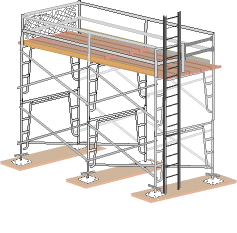Exploring the Numerous Kinds Of Scaffolding Used in Building And Construction Tasks
The building sector relies greatly on various types of scaffolding to satisfy specific task requirements, each offering distinct benefits and applications. Conventional frame scaffolding supplies a durable structure for basic tasks, while suspended scaffolding is vital for job on high-rise frameworks.

Typical Framework Scaffolding
Conventional structure scaffolding is one of one of the most commonly utilized methods in the building and construction sector because of its robustness and convenience. This system includes upright and straight structures that are constructed to develop a stable platform for products and workers. The main elements consist of vertical posts, horizontal ledgers, and angled dental braces, which together supply a solid framework that can support significant lots.
One of the crucial advantages of typical framework scaffolding is its adaptability to numerous building projects, ranging from residential structures to huge industrial frameworks. The modular design permits easy setting up and disassembly, making it reliable for both long-lasting and short-term projects. Furthermore, the system can be tailored in elevation and size, fitting various structure layouts and site problems.
Security is paramount in scaffolding applications, and conventional framework systems are furnished with guardrails and toe boards to protect against falls and guarantee employee protection. Additionally, routine evaluations and adherence to safety guidelines are vital in maintaining the stability of the scaffold. Generally, traditional structure scaffolding remains a fundamental choice in the building and construction market, supplying a trustworthy platform for labor and boosting general job performance

Suspended Scaffolding
Put on hold scaffolding provides a distinct service for construction tasks that require accessibility to raised surfaces, particularly in circumstances where standard framework scaffolding might be not practical. This sort of scaffolding is usually suspended from the roof covering or top levels of a framework, using a system of ropes, platforms, and wheels to develop a working room that can be adapted to numerous heights.
Among the primary benefits of put on hold scaffolding is its versatility. It can be conveniently repositioned or reduced to fit changes in building and construction needs, making it ideal for tasks such as home window setup, façade work, and maintenance on skyscrapers. Additionally, the very little footprint of suspended scaffolding enables for better use of ground space in metropolitan atmospheres, where area is usually restricted.
Safety and security is an essential consideration in making use of put on hold scaffolding. Proper rigging and securing systems must be employed to guarantee security and prevent crashes. Operators has to also be educated in the safe use of this devices. Generally, put on hold scaffolding gives a reliable and effective remedy for accessing hard-to-reach locations in different building and construction scenarios, boosting both performance and security on site.
System Scaffolding
System scaffolding, usually considered as a modern-day remedy in the scaffolding market, consists of pre-engineered components that can be promptly constructed and adjusted for different building projects. Scaffolding. This type of scaffolding is defined by its modular design, which enables versatility and performance on job sites, suiting structural needs and different heights
Typically made from high-strength steel or light weight aluminum, system scaffolding uses enhanced sturdiness and stability. The elements consist of upright blog posts, horizontal journals, and diagonal dental braces, which interconnect firmly, guaranteeing a durable framework. The design frequently incorporates standard installations, simplifying assembly and read disassembly procedures, thus reducing labor time and prices.

Rolling Scaffolding
Moving scaffolding is a versatile option to traditional fixed scaffolding, designed for movement and simplicity of use on building sites. This type of scaffolding is composed of a platform supported by frames with wheels, allowing employees to quickly relocate it as needed. The movement feature substantially improves performance, as it lessens downtime connected with setting up and dismantling taken care of scaffolding.
Commonly created from lightweight products such as light weight aluminum or steel, rolling scaffolding provides a durable yet mobile solution for jobs requiring frequent repositioning - Scaffolding. It is particularly beneficial in jobs such as paint, drywall installation, and electric job, where access to numerous elevations and locations is Resources essential
Security is vital in rolling scaffolding design, with features such as locking wheels to avoid unexpected motion when in usage, and guardrails to protect employees from falls. Additionally, several models are flexible in elevation, fitting different job needs.
Cantilever Scaffolding

The design of cantilever scaffolding normally includes utilizing brackets or arms anchored to a building or framework, making it possible for the system to prolong external safely. Safety and security is critical; therefore, these scaffolds must be crafted to stand up to different loads and ecological conditions. Routine evaluation and maintenance are necessary to make certain architectural honesty and worker safety and security.
Cantilever scaffolding is preferred for its flexibility and efficient usage of area, making it a popular selection in city settings where room restraints prevail. It helps with less complicated access to high altitudes, ultimately adding to the overall effectiveness of building and construction projects. Similar to all scaffolding types, appropriate training and adherence to safety requirements are crucial for employees utilizing cantilever scaffolding.
Verdict
Finally, the varied sorts of scaffolding utilized in building and construction jobs each offer distinct functions customized to specific site needs. Standard structure scaffolding provides stability, while put on hold scaffolding supplies versatility for elevated tasks. System scaffolding promotes fast assembly, and rolling scaffolding improves wheelchair for differing workplace. Cantilever scaffolding successfully resolves obstacles in urban settings. Understanding these scaffolding kinds is important for enhancing safety and security and performance in construction, ultimately contributing to the successful conclusion of jobs.
Traditional frame scaffolding provides a tough foundation for general jobs, while put on hold scaffolding is crucial for job on skyscraper structures.Rolling scaffolding is a versatile choice to typical set scaffolding, developed for movement and ease of usage on building sites. As visit homepage with all scaffolding types, correct training and adherence to safety and security criteria are important for workers making use of cantilever scaffolding.
Traditional structure scaffolding gives security, while suspended scaffolding supplies convenience for elevated tasks. System scaffolding promotes quick assembly, and rolling scaffolding boosts movement for varying job atmospheres.